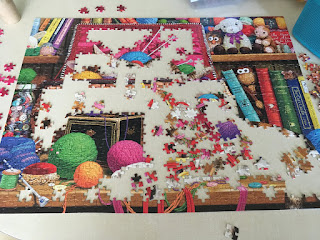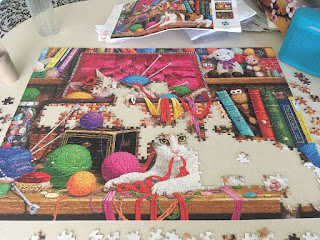My daughter didn't find puzzles interesting, so the most we ever did was 100 pieces, and that one of Pet Shops was probably finished by myself.
So I found some puzzles, none of which I even remember doing, and set them on an unused table, usually in front of the tv.
The first one was 500 pieces, and took me to Paris. It was a joy, and followed the rules I remember from the past. I started with the edge pieces, worked on the foreground with the most different items, and saved the building and sky pieces for later.
 |
| Paris with the wildest sky and a beautiful breakfast |
The next puzzle was so cute and complicated, and 1000 pieces, and I thought I was ready. I was wrong. It was not just a puzzle with double the pieces. I was not aware that the words "EuroGraphics" was about to change the whole approach I had to a puzzle. I hated every stupid piece, and yet I am glad to say I finished it. Not all edge pieces were obvious, and some pieces that looked like edges weren't. It was the first time that I couldn't start with a frame, to give it the right scale, and it often made me angry! The details kept me going though, with "1000" adorable cats, and a couple of surprises (at least one dog, one bunny and one duck!), and eventually I was able to move through like pieces, creating the colourful bits and finding their unique features to put them in order. Next came the faces, then tails, until I did have the edge in place, and bodies came together identified by the puzzle piece shape as much as the pattern.

 |



I have enjoyed the process of building puzzles. I may never manage to complete a New York crossword puzzle, but I may be able to find puzzles to keep my mind challenged. And I now know that I want a puzzle with enough pieces, and not too little, but also not too difficult. Like Goldilocks (synonyms: optimal, sweet spot) and the three bears, I want not too much, not too little, but just right!

No comments:
Post a Comment